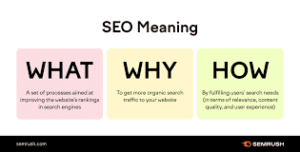
Using SEO (Search Engine Optimization) on your website is essential for improving your site’s visibility in search engines like Google, driving organic traffic, and increasing your website’s ranking. Here are the key steps to effectively implement SEO on your website:
1. Keyword Research
Identify Target Keywords: Use tools like Google Keyword Planner, SEMrush, or Ahrefs to find relevant keywords related to your business, products, or services. These are the words and phrases people search for on search engines.
Long-tail Keywords: These are longer phrases that are more specific and less competitive. They can drive highly targeted traffic to your site.
Analyze Competitors: Check what keywords your competitors are ranking for and try to target those keywords as well.
2. On-Page SEO
On-page SEO refers to optimizing individual web pages to rank higher and earn more relevant traffic in search engines.
Title Tags: Ensure each page has a unique and descriptive title tag that includes your target keywords. The title should be around 60 characters long.
Meta Descriptions: Write compelling and concise meta descriptions (under 160 characters) that include your main keywords. This helps search engines understand the page and improves click-through rates.
Headings (H1, H2, H3): Use proper heading tags to structure your content. The H1 tag is generally reserved for the main heading and should include the primary keyword.
URL Structure: Use SEO-friendly URLs that are short, descriptive, and contain your target keywords (e.g., www.yoursite.com/seo-services).
Content Optimization: Make sure your content is relevant, informative, and answers users’ queries. Include keywords naturally, without keyword stuffing, and use related terms (LSI keywords).
Internal Linking: Link to other pages or blog posts within your website. This helps distribute link equity across your site and enhances user navigation.
Image Optimization: Use descriptive file names and add “alt text” to images, incorporating relevant keywords to help with image search visibility.
3. Technical SEO
Technical SEO ensures your website is set up in a way that makes it easy for search engines to crawl and index.
Mobile-Friendly Design: Ensure your website is responsive and performs well on mobile devices. Google uses mobile-first indexing, meaning it primarily uses the mobile version of your site for ranking.
Site Speed: Page load speed is an important ranking factor. Use tools like Google PageSpeed Insights to analyze and improve your site’s speed. Compress images, leverage browser caching, and use content delivery networks (CDNs).
SSL Certificate: Ensure your website is secure with HTTPS, not HTTP. This is important for SEO and user trust.
XML Sitemap: Create and submit an XML sitemap to Google Search Console to help search engines crawl and index your pages.
Robots.txt File: Make sure you have a proper robots.txt file that guides search engine crawlers on which pages to crawl or avoid.
4. Off-Page SEO
Off-page SEO refers to actions outside your website that impact your search rankings.
Backlink Building: Backlinks (links from other websites to yours) are a major ranking factor. Focus on building high-quality backlinks from authoritative sites in your industry.
Guest Blogging: Contribute valuable content to other relevant websites or blogs and include backlinks to your site.
Social Media Sharing: While social media signals don’t directly affect SEO rankings, social media activity can drive traffic to your website and generate backlinks.
Online Directories and Reviews: Get listed in industry-related directories and encourage customers to leave positive reviews on platforms like Google My Business, Yelp, and Trustpilot.
5. Content Strategy
Quality content is key for SEO. By creating valuable, relevant, and consistent content, you can increase your chances of ranking higher.
Blogging: Start a blog and regularly publish high-quality, keyword-optimized articles that answer your audience’s questions.
Multimedia Content: Use videos, infographics, and podcasts, which are engaging and can attract more traffic.
Content Freshness: Regularly update your content to keep it relevant and fresh for users and search engines.
6. Local SEO
Local SEO is essential for businesses serving specific geographic locations.
Google My Business: Set up and optimize your Google My Business profile. Make sure your name, address, phone number, and business hours are correct and consistent across all platforms.
Local Keywords: Include location-based keywords (e.g., “SEO services in [City Name]”) in your content, meta descriptions, and title tags.
Local Listings: Get listed in local business directories and industry-specific directories to improve local search visibility.
7. Tracking and Analytics
Google Analytics: Set up Google Analytics to track website traffic, user behavior, and other key metrics. It helps you understand what’s working and where to make improvements.
Google Search Console: Use Google Search Console to monitor your website’s search performance, track keyword rankings, identify indexing issues, and see how Google crawls your site.
SEO Tools: Use tools like SEMrush, Ahrefs, or Moz to analyze your backlinks, track rankings, and research competitors.
8. User Experience (UX) and Engagement
Google values user experience, so improving the design and functionality of your website can help with rankings.
Navigation: Ensure your website is easy to navigate and that visitors can find what they’re looking for quickly.
Bounce Rate and Dwell Time: Reduce bounce rates by providing engaging, high-quality content. Improve dwell time by ensuring your site is fast and easy to navigate.